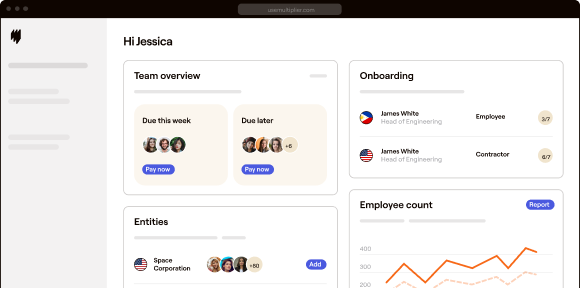Companies nowadays are increasingly leveraging technological advancements to build a globally distributed workforce. This shift towards workforce globalization provides access to a diverse global talent pool, drastically altering how businesses operate and compete on the international stage.
However, the opportunities of a global workforce come with its own set of challenges. As organizations stretch across borders, they constantly need to manage a multitude of cultural nuances and strict regulatory frameworks.
A recent report revealed that 52% of professionals now regularly work remotely, clearly signalling a shift towards more flexible and virtual team structures. This trend necessitates HR managers to carefully navigate the complexities of local and international labor laws, ensuring strategic alignment and fostering robust cross-border collaboration.
Let’s explore the key challenges organizations face in managing global workforces, the strategies they can implement to overcome these hurdles, and the global workforce trends that will shape the future of workforce management.
Global talent management: Strategies for success
In this era of globalization, talent knows no borders. Companies are increasingly tapping into global talent pools to onboard the best candidates. Here’s how organizations can build a winning team on a global scale:
- Building your brand: A strong employer brand helps a lot in attracting the right talent. This involves showcasing your company’s unique values, culture, and mission to potential recruits.
- Aligning talent with strategy: HR practices must align seamlessly with the broader business objectives. This includes revising performance appraisals to emphasize strategic priorities and ensuring uniformity in recruitment, development, and compensation policies.
- Investing in talent development: Giving due emphasis to talent development through mentorship and continuous learning programs fosters growth and helps maintain a highly skilled workforce. This involves providing global training initiatives that emphasize company values, ethics, and commitment to skill-building.
- Striking the right balance: Successfully operating a global workforce means balancing global standards with local preferences. By creating a strong, unified framework that allows for regional customization, companies can maintain consistency in best practices while adapting to local regulations and cultivating local talent.
Managing a global workforce: Challenges and solutions
Managing a global workforce offers numerous advantages. However, it also presents unique challenges that organizations must address. Let’s check out some of the challenges along with solutions for managing a global workforce.
- Cultural Differences
Managing a global workforce often involves interacting with people from diverse cultural backgrounds. These differences can manifest in various ways, including communication styles, work ethics, and expectations. Misunderstandings and conflicts can arise if these cultural nuances are not addressed effectively.
Solution: Investing in cross-cultural training and encouraging open, respectful communication fosters understanding, empathy, and effective collaboration across diverse teams. This approach helps an organization to promote a more inclusive and connected work environment. - Language barriers
Language barriers can hinder effective communication and collaboration among global teams. Misunderstandings and errors can occur due to differences in dialects, accents, and cultural nuances.
Solution: A practical approach is to provide language training or utilize translation tools to enhance team communication. It is equally important to promote a culture of clear, jargon-free communication to ensure understanding and avoid confusion across diverse teams.
Multiplier offers tools to streamline communication and performance management. It supports automated performance tracking and feedback systems, helping managers maintain productivity and address issues promptly. - Time zone differences
Coordinating work across different time zones can be challenging, leading to scheduling conflicts, reduced productivity, and missed deadlines.
Solution: To manage time zone differences, organizations can implement flexible work schedules that allow for overlapping hours, ensuring better coordination. Using asynchronous communication tools also can immensely help teams global teams collaborate effectively. - Legal and regulatory compliance
Navigating the complex legal and regulatory landscape of different countries can be a significant challenge for global businesses. Non-compliance can result in fines, penalties, and damage to the company’s reputation.
Solution: Companies should partner with legal experts on international labor laws to ensure compliance and have clear global HR policies for contracts, benefits, and compensation. Regular audits in this case help ensure everything is running smoothly and highlight areas for improvement.
Multiplier simplifies compliance by centralizing the management of local labor laws. Their platform ensures that all employment contracts, payroll, and benefits adhere to local regulations, reducing the risk of legal issues. - Talent acquisition and retention
Attracting and retaining top talent in a global market can be competitive. Differences in compensation, benefits, and work culture can influence employee decisions.
Solution: Companies operating globally should offer competitive pay, and growth opportunities through mobility programs. It is also vital to foster a positive work culture with development and engagement initiatives to keep employees motivated and satisfied. - Technology and infrastructure
Ensuring access to reliable technology and infrastructure can be a challenge in some regions, particularly in developing countries. This can impact productivity and collaboration.
Solution: Companies should not shy away from investing in relevant technology and infrastructure to support global operations. They should also provide employees with secure remote access to systems and data, while offering training and support to ensure effective use of new tools.
The EOR advantage: Simplifying global workforce management
Managing a global team can be quite a complex affair owing to factors like varying labor laws, cultural distinctions, and administrative hurdles. This is precisely where the services of an Employer of Record (EOR) become highly valuable. EORs provide a comprehensive suite of services that optyimize global workforce talent management:
- Ensure adherence to complex labor laws and regulations, mitigating legal risks and penalties.
- Handle payroll, benefits, and HR functions, freeing businesses to focus on core operations.
- Facilitate global talent sourcing and help retain employees who relocate internationally.
- Provide expert guidance and support to navigate the complexities of international employment, minimizing risks and ensuring compliance.
- Offer a scalable and flexible solution for businesses entering new markets, reducing the administrative burden and costs associated with global expansion.
- Provide localized HR support, ensuring a positive employee experience and fostering a strong company culture.
- Offer valuable insights and advice on best practices for managing a global workforce, helping businesses make informed decisions.
Here’s a case study demonstrating Multiplier’s effectiveness in global talent management:
Mindvalley, a rapidly growing ed-tech company, struggled to navigate the complexities of global expansion. Setting up local entities to access international talent pools was sluggish and expensive.
Enter Multiplier, a highly robust and user-friendly SaaS-based EOR platform that enabled Mindvalley to effortlessly hire talent from a pool spanning over 150 countries. Here are some of the key factors contributing to Mindvalley’s success with multiplier.
- Faster and smoother hiring: Multiplier’s instant contract generation feature significantly expedited Mindvalley’s hiring process.
- Enhanced customer experience: A dedicated Customer Success Manager (CSM) ensured a smooth onboarding experience for Mindvalley’s new hires.
- Informed decision-making: Mindvalley’s people leaders were empowered to make well-informed decisions with the help of Multiplier’s built-in salary calculator and country-specific onboarding guides.
By leveraging Multiplier’s comprehensive EOR solution, Mindvalley was able to hire 18 employees across Europe and Asia in record time. This accomplishment serves as a testament to Multiplier’s ability to streamline global talent management and empower businesses to pursue their international expansion goals with greater confidence.
Multiplier: Your global workforce management partner
With Multiplier, you can easily expand your business globally without the complexities of setting up legal entities or navigating intricate local employment laws. Our platform offers a seamless EOR solution for hiring, onboarding, and managing your global team.
Key benefits:
- Cost-effective expansion: Save up to 90% on costs associated with payroll and legal entity setup.
- Global talent access: Tap into a vast pool of skilled professionals worldwide.
- Compliance assurance: Ensure adherence to local labor laws and regulations in every country you operate.
- Simplified management: Centralize your HR processes, including payroll, benefits, and time off, on a single platform.
- Dedicated support: Benefit from our team of local HR experts and 24/5 customer support.
The Multiplier platform streamlines HR processes. You can generate compliant contracts, facilitate onboarding, offer competitive benefits, and ensure accurate payroll in multiple currencies. Additionally, the platform centralizes management for HR functions, making it easier for HR teams to handle a global team.
A solution such as Multiplier could just be what you’re looking for — a comprehensive suite of HR solutions with a focus on compliance, support, security, and local expertise. The team of experts ensures adherence to local regulations, provides personalized assistance, protects data with strong security measures, and offers valuable insights into local labor markets.
To master workforce efficiency, explore these workforce management tools.
FAQ:
- How do you develop a global talent management strategy?
Developing a global talent management strategy involves aligning talent practices with business goals, ensuring internal consistency, embedding cultural awareness, involving management, balancing global and local needs, and differentiating employer branding. - What is the impact of globalization on workforce management?
Globalization impacts workforce management by increasing cultural diversity, expanding the talent pool, requiring compliance with international labor laws, and necessitating advanced technology for managing a dispersed workforce. - What tools are used for managing a global workforce?
Tools for managing a global workforce include those to enhance communication, collaboration, and operational efficiency. A good toolkit will include scheduling software that accommodates different time zones, project management platforms for task delegation and progress tracking, communication tools to foster real-time and asynchronous interaction among distributed teams, and data analytics solutions to provide insights into performance and engagement. - What are the best practices for managing a remote global workforce?
Best practices include respecting work-life boundaries, maintaining frequent communication, adapting hiring and onboarding processes, providing access to CRM tools, understanding the link between productivity and mental health, offering self-service resources, and helping workers set meaningful goals.







